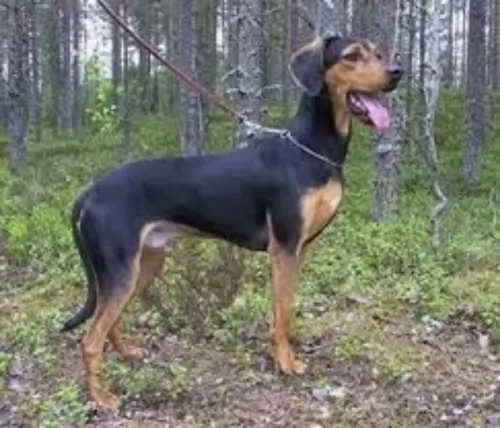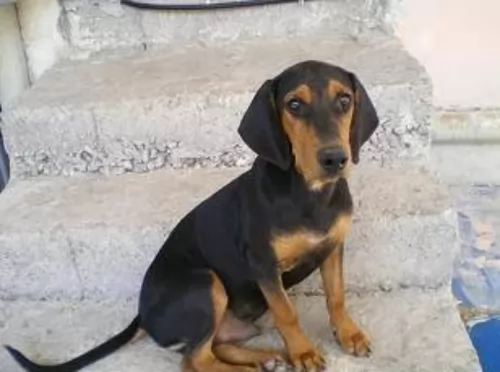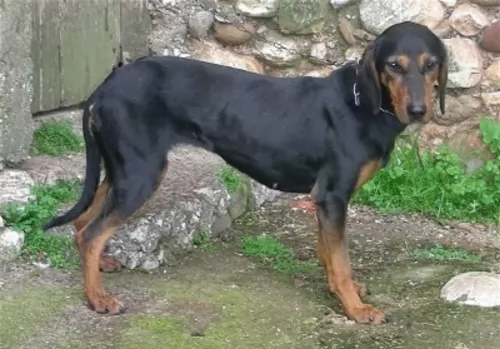 Petzlover
Petzlover Greek Harehound is originated from Greece but Hungarian Hound is originated from Hungary. Greek Harehound may grow 10 cm / 3 inches shorter than Hungarian Hound. Greek Harehound may weigh 7 kg / 15 pounds lesser than Hungarian Hound. Both Greek Harehound and Hungarian Hound has same life span. Both Greek Harehound and Hungarian Hound has same litter size. Both Greek Harehound and Hungarian Hound requires Low Maintenance.
Greek Harehound is originated from Greece but Hungarian Hound is originated from Hungary. Greek Harehound may grow 10 cm / 3 inches shorter than Hungarian Hound. Greek Harehound may weigh 7 kg / 15 pounds lesser than Hungarian Hound. Both Greek Harehound and Hungarian Hound has same life span. Both Greek Harehound and Hungarian Hound has same litter size. Both Greek Harehound and Hungarian Hound requires Low Maintenance.
 Known also as the Hellenic Hound, the Greek Harehound is an ancient breed, and it is a dog which has come down through the ages with very little change to the way he looks.
Known also as the Hellenic Hound, the Greek Harehound is an ancient breed, and it is a dog which has come down through the ages with very little change to the way he looks.
The ancestors of the Greek Harehound go back thousands of years and are believed to be the ancient ‘Laconikoi’ dogs of the Peloponnese.
In was in 1996 that the Federation Cynologique Internationale recognized the Hellenic Hound. The Greek Harehound was also recognized by the United Kennel Club (UKC) in 2006.
 The Hungarian Hound, also known as the Transylvanian Hound, originated in ancient Hungary as a hunting dog. At the time there were Asian Hounds that traveled with Hungarian Magyar tribes into Transylvania. As early as the 9th century it is believed that these Hungarian dogs were crossed with Celtic Hounds and local dogs. The result is the Hungarian Hound. These dogs were incredibly popular throughout Transylvania.
The Hungarian Hound, also known as the Transylvanian Hound, originated in ancient Hungary as a hunting dog. At the time there were Asian Hounds that traveled with Hungarian Magyar tribes into Transylvania. As early as the 9th century it is believed that these Hungarian dogs were crossed with Celtic Hounds and local dogs. The result is the Hungarian Hound. These dogs were incredibly popular throughout Transylvania.
This scent hound almost became extinct but was saved by intense breeding during the latter part of the 21st century. They developed two kinds, short and tall, for different types of hunting. The tall dogs hunted boar, bison, lynx and bear. The short dogs hunted hare, fox and chamois.
Only the tall dogs exist today. Some Hungarians raided parts of Europe and took the dogs with them. There was then a crossing breeding with Polish dogs. The tall dogs exist today in Hungary and Romania. The Hungarian Kennel Club recognized the breed and the United Kennel Club (UKC) from the United States recognizes them. No major clubs such as the AKC (American Kennel Club) or the British Clubs. The breed was accepted into the AKC Foundation Stock Service Program
 These dogs have a short, dense coat which is black and tan in color. He is a medium sized, well proportioned, deep chested dog standing at roughly 47 – 55cm in height and weighing between 17–20kg.
These dogs have a short, dense coat which is black and tan in color. He is a medium sized, well proportioned, deep chested dog standing at roughly 47 – 55cm in height and weighing between 17–20kg.
His legs are straight, well boned and strong. The skull of the dog is fairly flat, the eyes are brown while the ears are set high and are floppy. The tail is long, tapering down to a tip.
Lively and outgoing, the Greek Harehound is a skilled, brave hunter. These are active dogs and will require quite a bit of exercise if you get one as a pet. He becomes devoted to his owner, making a good, all-round family pet.
He has always been used in the past to hunt in packs so he gets on well with any other dogs in the family.
As a scenthound, the Greek Harehound is an independent, stubborn, strong-willed dog that will respond well to a firm, strong owner. His stubborn, strong-willed nature means it will be important to have him trained and socialized so that he becomes a well-rounded, obedient pet.
If you're looking for a true around-the-house family pet, this isn't the ideal choice as he is essentially a hunting dog, wanting to be running off on a hunt as opposed to lying quietly indoors. He is therefore better suited to life in the country than being cooped up in a small city property.
 The Hungarian Hound is a medium sized dog, a scent hound with the same characteristics of the type of hunting hounds found in Mid-Europe. The breed is a hardy one with a long head slightly domed skull. The muzzle is short, and the jaws are strong. The lips are black, and the ears are round and hang. Their eyes are shaped like almonds and dark brown. The breed has large paws with cushioned pads and strong toes.
The Hungarian Hound is a medium sized dog, a scent hound with the same characteristics of the type of hunting hounds found in Mid-Europe. The breed is a hardy one with a long head slightly domed skull. The muzzle is short, and the jaws are strong. The lips are black, and the ears are round and hang. Their eyes are shaped like almonds and dark brown. The breed has large paws with cushioned pads and strong toes.
 Fast, courageous, smart, playful, independent and strong willed, the Greek Harehound is a slow maturing breed and he will require training and socialization to make him obedient and not so stubborn.
Fast, courageous, smart, playful, independent and strong willed, the Greek Harehound is a slow maturing breed and he will require training and socialization to make him obedient and not so stubborn.
Once trained he becomes a truly wonderful companion, being affectionate, loyal and outgoing. He makes a good friend of children too.
He is friendly and non-aggressive, though he still makes a good watchdog. He is a low maintenance pet too, and even though he is essentially a hunting dog, he can make anyone a splendid pet.
 Children friendliness – This breed is very friendly with children.
Children friendliness – This breed is very friendly with children.
Special talents - Hunting independently and at a distance from the hunter.
Adaptability – Not an apartment dog. They need space and land.
Learning ability – They are very independent and intelligent.
 The Greek Harehound is a healthy dog breed with no particular genetic defects. But like other dogs with floppy ears, they are more prone to infections and the insides of the ears will need to be cleaned frequently. Always do this with the utmost care to avoid damaging your pet's ears.
The Greek Harehound is a healthy dog breed with no particular genetic defects. But like other dogs with floppy ears, they are more prone to infections and the insides of the ears will need to be cleaned frequently. Always do this with the utmost care to avoid damaging your pet's ears.
He is a deep chested dog and this puts him at risk of gastric dilation and volvulus which is commonly referred to as bloat. Its a life threatening health issue where the stomach can twist. The stomach is sealed off as a result and gas builds up. The dog can go into organ failure.
 Even though this is an ancient breed they do face certain medical issues such as:
Even though this is an ancient breed they do face certain medical issues such as:
 The Greek Harehound is happiest when he senses he is free to follow scents and run. This is why this particular dog breed isn’t suited for life in the city where he has a small garden. He requires large pieces of ground to run free. If you own one of these dogs, he should be taken on daily walks and be involved in lots of sporting activities and games. If you’re a jogger or cyclist, this dog will be thrilled to join you.
The Greek Harehound is happiest when he senses he is free to follow scents and run. This is why this particular dog breed isn’t suited for life in the city where he has a small garden. He requires large pieces of ground to run free. If you own one of these dogs, he should be taken on daily walks and be involved in lots of sporting activities and games. If you’re a jogger or cyclist, this dog will be thrilled to join you.
Dog owners love that this dog is a low maintenance breed. The short coat simply requires a brush twice a week to rid him of loose hairs and to also keep his coat shiny and healthy.
Every new puppy will require a series of vaccinations in his first year to make sure he doesn't develop some of the serious dog diseases there are such as distemper, parvo-virus and rabies among others.
Dogs are carnivores and without human interference have always eaten fresh meat in the wilds. For convenience many people feed their dogs commercially manufactured food.
There are some excellent brands. Choose the best one for your pet and mix in raw meat from time to time as well as cooked rice, chicken and vegetables.
Never leave your pet without a constant supply of fresh, cool water.
 Feeding the puppy – 1-3 cups of high quality food served in 3-5 meals per day.
Feeding the puppy – 1-3 cups of high quality food served in 3-5 meals per day.
Feeding the adult – 3-5 cups of high quality food served in 2-3 meals a day.
Points for Good Health – generally healthy
Games and Exercises – The Hungarian Hound is a hunting dog and therefore accustomed to and bred for a high level of exercise. Their instinct for hunting is really strong so make sure you do not let them off leash outside of a contained area. They excel at tracking, field trials, lure chasing, and fly ball.